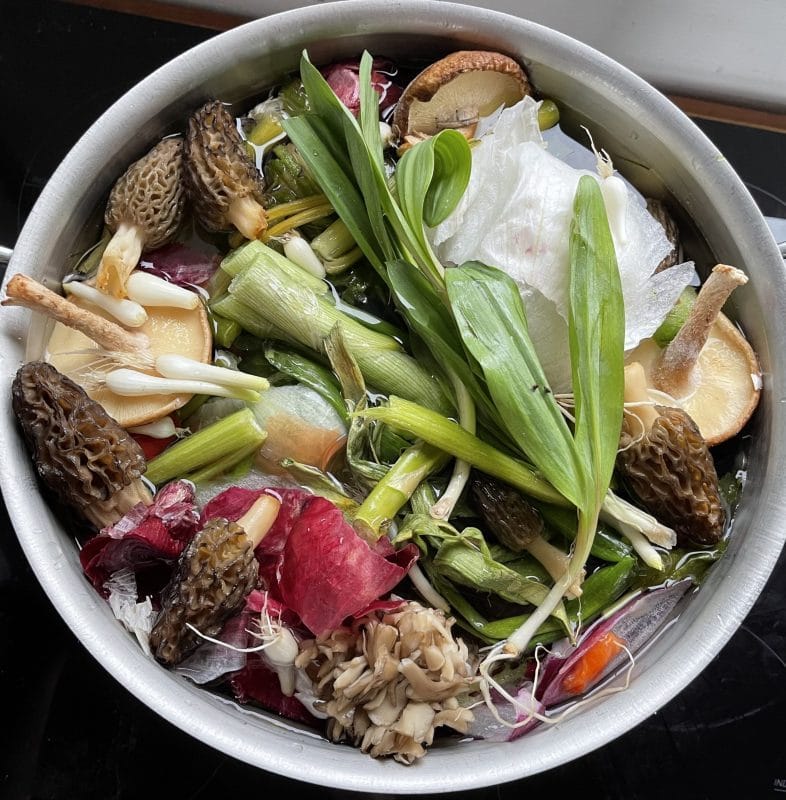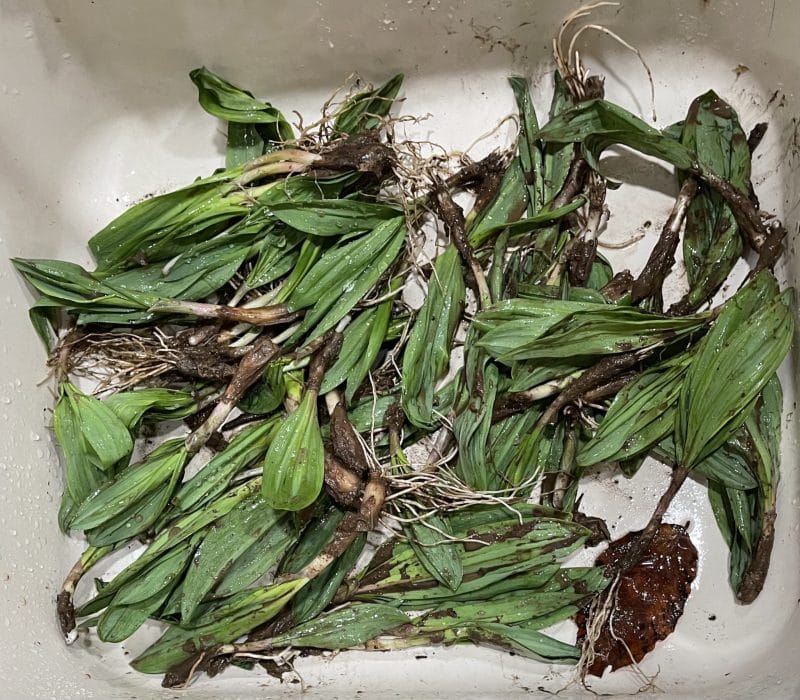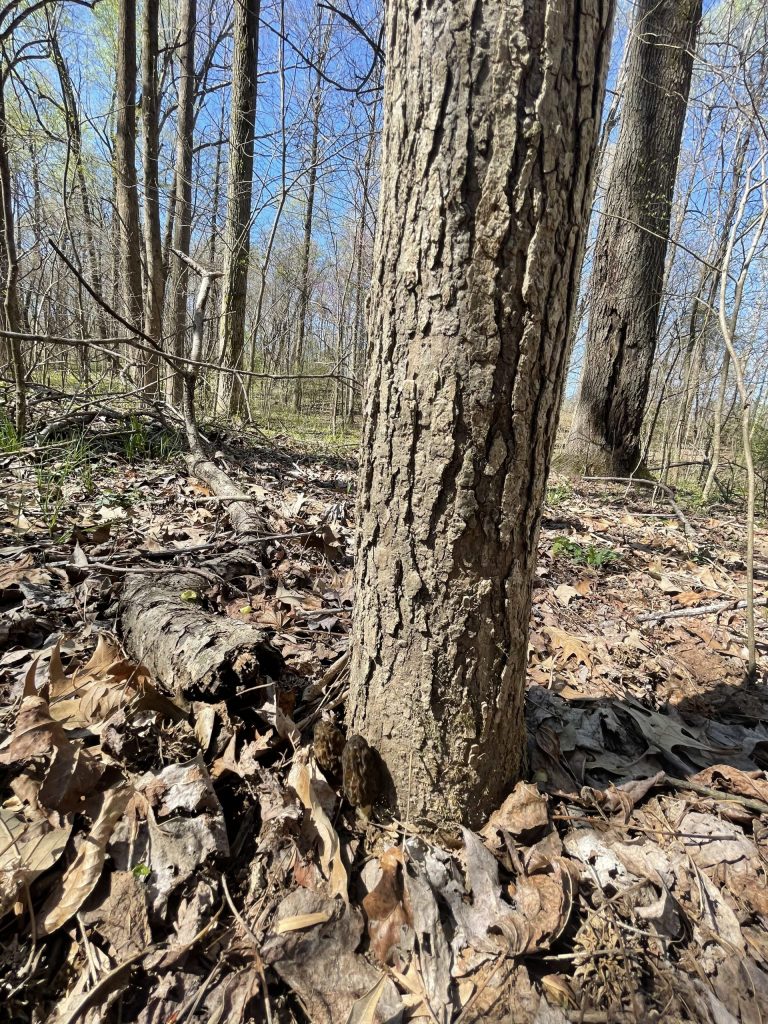This recipe and blog post was created by an anonymous Lotus supporter as part of Sexual Assault Awareness & Prevention Month.


The noodle bowl from above.
Foraging is a fantastic form of self care. Tasks like cleaning mushrooms, prepping, preserving, creating ingredients for future meals, are all acts of mindfulness. The “work” becomes meditative, creative, and physically and mentally nourishing to the body. In fact, time spent under the canopy of trees has been scientifically proven to benefit us in a number of ways.
On top of feeling your best, there is really nothing like studying wild fungi, walking out into the woods, picking up a freshly fruited mushroom, gathering some greens, cooking them, eating, and being so thrilled that it tastes wonderful and unlike any mushroom or food you’ve ever eaten before.


Our gut health is directly linked to our mental health, and a diversity of plants is the key to a healthy gut. This recipe is pretty free-flowing and can be used throughout the seasons with different ingredients. Outside, waiting for us, is a plethora of foods we do not normally consume. Here we used chickweed, purple nettle, dandelions, yarrow, violets, and morel mushrooms! Considered a superfood, mushrooms boost immunity. Combining locally foraged foods with locally grown foods* is my favorite way to cook. Wild foods are full of wildly beneficial nutrients, and our bodies are begging for them.

Some of the edible flowers and greens you can find in your yard—violets, yarrow, chickweed, dandelions, and purple nettle.

In this recipe, the broth is no more complex than a simmering of your leftover vegetables and some reinforcements. Cut up an onion? Take what’s left and start a bag in the freezer for your future broth. Same for your carrots and basically every vegetable you cut up that has something left of it. In this manner, you’ve taken what may have made for good compost, made a delicious broth, and you still have excellent compost after your broth is strained. Recycling in double time. In addition to your extra veggies, a variety of fresh local mushrooms (we love lions mane), a few slices of ginger and spices like turmeric and black pepper provide a mega-load of nutrients.

An example of a homemade broth base, ready to be simmered.

By itself, the broth is an excellent probiotic drink. For this recipe, it will serve as the base.

After the broth has simmered for a few hours and strained.

In our recipe, we also used wild ramps, a member of the allium genus of plants that includes garlic and onions. Though we don’t have a local source of these, we received them as a gift from a fellow forager who found them in the higher elevations of West Virginia. A formidable allium substitute that we also included is the commonly invasive wild garlic. You can distinguish wild garlic by its stem which is round and hollow, and its scent which is distinctly garlicky. Any time of the year that you find this is a good time to use it.

Muddy ramps, freshly delivered.

Other ingredients include spices, a medium-sized onion of any variety, wheat-based ramen noodles (though many other kinds of noodles will suffice), and bok choy. While you can follow this as strictly as you want, it is wide open to bio-individuality. The more mushrooms and plants, the happier you and your body.

The morels all piled up on the cutting board, ready to be cooked!

Ingredients
• Half of a gallon of the broth. If you make your own as detailed above, you might have some left over. Save it for more noodles or a delicious, healthy drink.
• Ramen style noodles. We used roughly 4 dry oz here.
• Two cups of wild greens and florals
• Cup of wild alliums (wild onions, ramps, or wild garlic)
• However many mushrooms you’d like. We used about one cup of morels.
• One whole onion
• Olive oil
• A few cloves of minced garlic
• Black pepper, turmeric and any other spice to your preference
• Bok choy (and any other vegetable you want)
• Salt to taste

A couple halved Bok Choy.

Steps to Prepare
1. Cut bok choy in half, top to bottom.
2. Cut whole onion from top to bottom, then slice into thin half-moon shapes.
3. Coat large pot with olive oil, and place the onion and minced garlic into the pot, spreading it evenly. Cook until brown.
4. Combine broth, onions and garlic. Add black pepper, turmeric, and any other spices of your preference. Simmer.
5. Coat small pan in olive oil, cook the wild allium mix and bok choy and other vegetables until brown. Place to the side.
6. On a cutting board, cut half cup of morels through the middle. Mince remaining half cup of mushrooms.

The morels cut in half and into smaller pieces. Notice that true morels are completely hollow chambers.
Steps to Prepare Continued
7. Pour all of your mushrooms into a dry pan and sweat out any excess moisture. When you can see no moisture coming from the mushrooms and they are beginning to brown, pour over a small amount of olive oil and salt. Cook until well done and crispy.
8. Place the minced portion of mushrooms into your broth pot and bring to a boil. Place your ramen into the boiling mixture, and reduce to high simmer.
9. Mix in the cooked wild allium and vegetable mix.
10. Test to make sure the ramen is cooked to the right texture, then top with wild greens and whole cooked mushrooms.
11. Enjoy a delicious meal!
 Finding your own food is for anyone and everyone. You are smart enough to do this! Be safe and well informed as you forage (you can start your education by following educators like @breakfast_of_champignonz on Instagram). Make friends. Ask questions. You don’t need your own woodlot. The national parks belong to us. Go to them! Blackberries and chanterelles in the summer and oyster mushrooms frozen to the trees in January will be waiting for you.
Finding your own food is for anyone and everyone. You are smart enough to do this! Be safe and well informed as you forage (you can start your education by following educators like @breakfast_of_champignonz on Instagram). Make friends. Ask questions. You don’t need your own woodlot. The national parks belong to us. Go to them! Blackberries and chanterelles in the summer and oyster mushrooms frozen to the trees in January will be waiting for you.
[Note: Collecting or disturbing mushrooms is prohibited on many national park service lands. However, in some parks, small amounts of edible mushrooms may be collected for personal use, limited to a maximum quantity per person per day. Note that many mushrooms are poisonous and should not be eaten unless you are able to correctly identify the species and know that it is edible. Collecting mushrooms for research or educational purposes may be allowed, but requires a permit. For more information, please visit park websites for regulations on mushroom collecting in specific parks.]
For more information check out:
Suzanne Simard Ph.D. Forest Sciences
Pascal Baudar, Urban Outdoor Skills
Interwoven Permaculture
Will Bulsiewicz, MD, MSCI
*Join a CSA with Made in Kentucky Farms. It is SO yummy.











